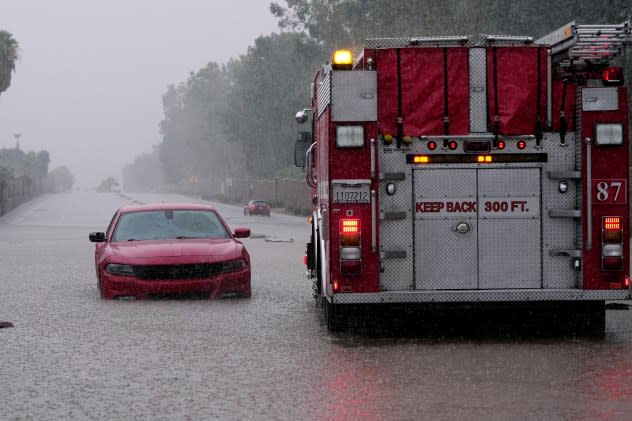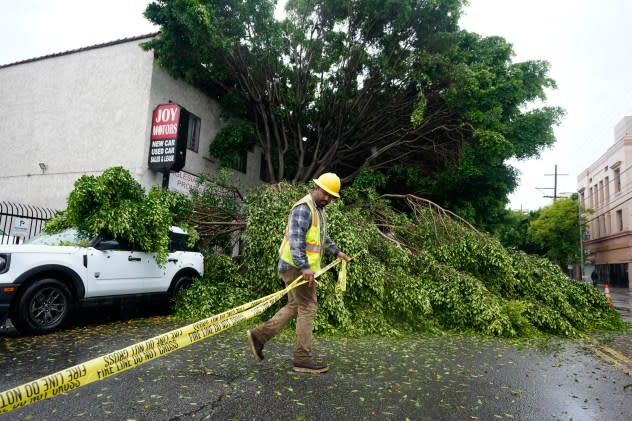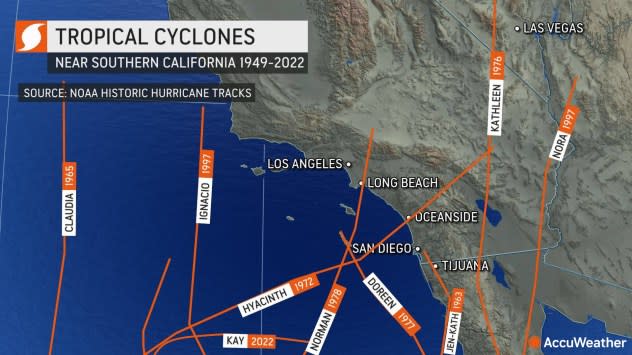Hurricane Hilary was a storm to remember for Southern California
Hilary will go down in the record books as the most impactful tropical system to impact California in recent history, retired AccuWeather Expert Meteorologist Ken Clark, a California native, said. Here's why.
As AccuWeather accurately predicted days in advance and ahead of other sources, Hilary brought widespread flooding through Southern California, washing out roads and bridges in many areas, flooding cars and homes and shutting down businesses and governments, including in Los Angeles and San Diego.
 |
AccuWeather's preliminary estimate of the total damage and economic loss from Hilary in the United States is $7-9 billion .
"As Hilary's rain moved into the U.S., the storm was moving along swiftly at 20 mph or greater but still produced widespread heavy rain and flash flooding, especially in the mountains and the deserts," AccuWeather Chief Meteorologist Jonathan Porter explained. "Had the storm been moving along at a more typical forward speed for tropical storms, such as 10-12 mph, rainfall could have been much worse than it was, with even more severe impacts."
Hilary brought the wettest summer day on record to at least 16 cities in California. An entire year's worth of rain fell in one day in some areas. Death Valley, California, broke its all-time record daily rainfall of 2.20 inches. The previous record was set just last summer when 1.70 inches of rain was measured on Aug. 5, 2022.
The heaviest rain was reported in the mountains, with Mt. San Jacinto reporting 11.74 inches. Hilary's rainfall then moved northeastward, where new state records were established for tropical cyclone rainfall in Nevada, Oregon, Idaho and Montana.
 |
A fire truck pulls away after a motorist became stranded in rising floodwaters caused by torrential rain brought by Tropical Storm Hilary, Sunday, Aug. 20, 2023, in Palm Desert, Calif. (AP/Mark J. Terrill) |
Tropical-storm-force winds from Hilary howled across most of the mountains in Southern California, a stark comparison to Kathleen or Nora, Clark explained. The peak gust from Hilary recorded by National Weather Service stations was 87 mph at Magic Mountain, with several gusts over 80 mph at other locations.
Almost no weather stations measured wind gusts on California mountains before 2000, so the best wind gust comparison is with Tropical Storm Kay in 2022. Wind gusts during Kay were higher, peaking at 109 mph on Cuyamaca Peak, California, with several readings in the region over 90 mph.
 |
A worker drags caution tape to block off Pico Boulevard after a tree fell, Sunday, Aug. 20, 2023, in Los Angeles. Tropical Storm Hilary swirled northward Sunday just off the coast of Mexico's Baja California peninsula, no longer a hurricane but still carrying so much rain that forecasters said "catastrophic and life-threatening" flooding is likely across a broad region of the southwestern U.S. (AP Photo/Ryan Sun) |
Tropical Storm Kay last year is the only previous storm in the area that can be compared by the lens of power outages since it was the first tropical storm to affect Southern California in more than 25 years.
Power outages during Hilary in southern California were greater than those during Tropical Storm Kay in 2022, peaking at around 24,000 customers, according to Jason Robinson from PowerOutage.US. During Kay, outages were closer to 5,000, and not all could be attributed to weather. Additional outages that were unrelated to Hilary happened in northern California over the weekend.
 |
Tropical cyclone tracks approaching southern California since 1949. |
Hilary made landfall in Mexico's Baja California Peninsula on Aug. 20, 2023, and tracked east of San Diego as a tropical storm. No system has made landfall in California at tropical storm strength since record-keeping began in 1949.
Weather impacts from storms that were once tropical in nature have affected the state in the past, but it's been a very long time since a tropical storm hit the state directly.
"Hilary will go down as much more impactful for California than Kathleen (1976) or Nora (1997), as both of those storms' greatest impact was limited to the southeast part of the state," Clarks said.
California was just impacted by Tropical Storm Fay just a year ago, but Clark says Hilary won the award for the most rain "hands down in the San Diego area and over all of Southern California from the border north to the Southern Sierra, including of course the astounding Death Valley record."
Ten years before official National Hurricane Center records began, most meteorologists agree that a tropical storm landed at Long Beach, California, in 1939. It remains the only landfalling tropical storm in the state because Hilary made landfall in the Baja California Peninsula of Mexico.
In 1858, a hurricane moved just offshore from Los Angeles but never made landfall. Very little data is available for these storms, which would have had a much more pronounced effect today due to an explosion in people and infrastructure. San Diego's population in 1858 was around 4,000 while it is 1.4 million today.
Want next-level safety, ad-free? Unlock advanced, hyperlocal severe weather alerts when you subscribe to Premium+ on the AccuWeather app. AccuWeather Alerts™ are prompted by our expert meteorologists who monitor and analyze dangerous weather risks 24/7 to keep you and your family safer.





